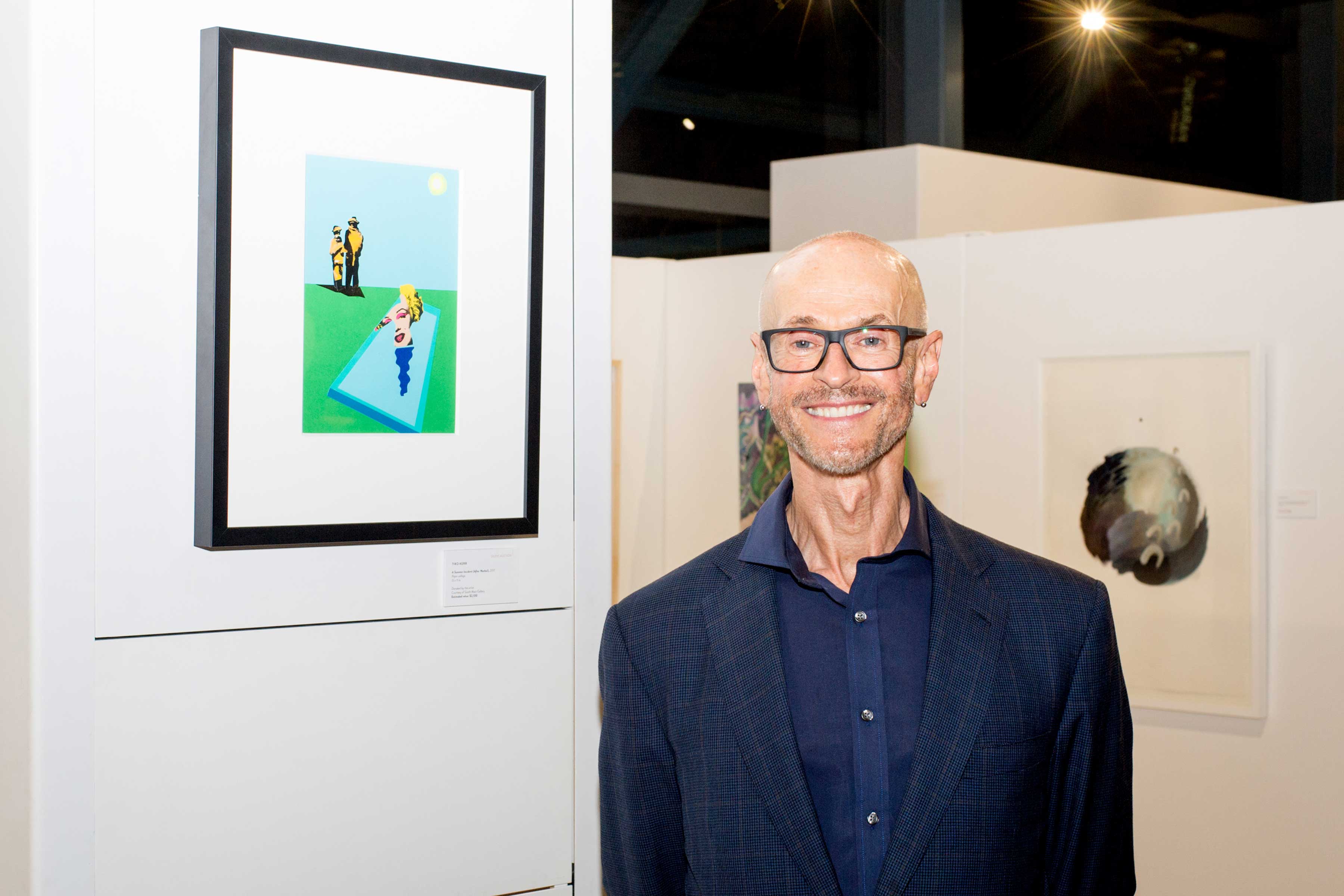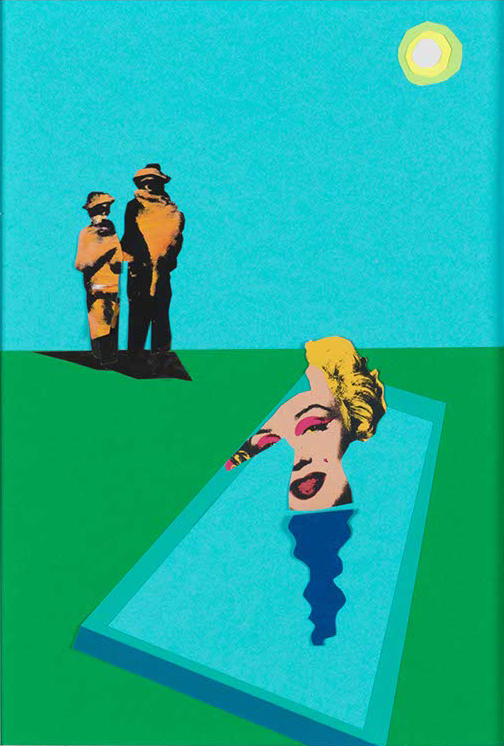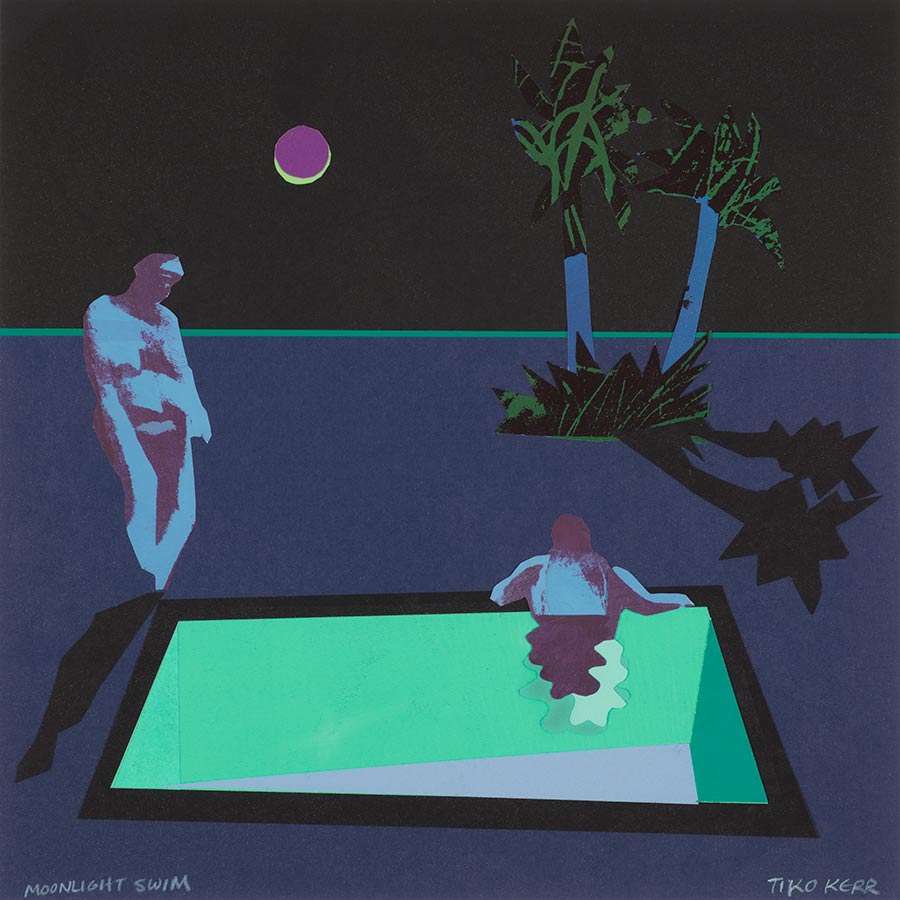
I believe, with the dwindling resources of the modern world, the only true resource we can rely upon is creativity — to get us through social problems and environmental problems and everything else. Creativity is essential to our survival.
Tiko Kerr is no newcomer to Splash. He’s been donating since 1991. Known for his bold, colourful paintings, Kerr submit something a little different this year: a paper collage. A Summer Incident (After Warhol) still uses bold colours, but Kerr adopts a new medium to brilliant effect, mashing art history and pop culture.

A Summer Incident (After Warhol), 2017
Paper collage
The new style certainly didn’t come out of nowhere; the basis of his work began when Kerr was young. An only child raised in Edmonton in the 50s, Kerr grew up drawing on the chalkboard.
“My mother was a schoolteacher and I would have to kill a lot of hours while she was marking papers,” Kerr explains. “So I drew on the blackboard — we had blackboards in those days — and I’ve really come to realize that that was where I got a real sense of form and abstraction and seeing things in abstract shapes. However, I was really drawn to science, and it’s what I studied and went to university and got my degree in because I wanted to become a doctor.”
I wanted to take a break, so I decided to go backpacking, for what I thought would be a couple of months. I was gone for six years.
With a proclivity for science and a worsening diagnosis for eye aberrations, it’s no wonder that Kerr pursued a degree in science in preparation for medical school. Following his bachelor’s, however, he was ready for a change of pace.
“I wanted to take a break,” he says of his decision to travel. “So I decided to go backpacking, for what I thought would be a couple of months. I was gone for six years. I lived in Australia, in Indonesia, taught scuba diving, did all kinds of interesting things. The whole time, I filled sketchbooks with drawings and watercolours of my experiences.”
When he finally returned to Canada, Kerr landed in Vancouver for Expo 86. During those six years of travel a lot had changed in the world, in Canada, in Vancouver, and for Kerr himself.
“I’d changed so dramatically from the person I was before that it was easy for me to make the transition to a whole new [field]. Being male and in my 20s and English-speaking and white, there were no doors not opened to me in those days. I had an audacity that I could pull anything off. So that’s what’s kept me going: confidence in my work and confidence in my personal strength.”

Moonlight Swim (After Warhol), 2016
Paper cut collage
Kerr’s Silent Auction piece donated at Splash 2016
I’m trying to paint as honestly as I can, as I think all painters do. And I think that’s what’s resonated with a lot of people, seeing the world through my crazy eyes.
And while Kerr recognizes his privilege, he has had to draw on strength of a different kind throughout his life. For starters, he has eye aberrations that have worsened over time. “I’ve got horizontal astigmatism in my left eye and I’ve got a vertical astigmatism in my right eye,” explains Kerr. He uses it for his art, though: “I’ve also got a blind spot, which causes haloing, so when I look at primary colours, I always get a complementary colour halo around it. So for purples, I see a yellow around it and for blues I see an orange around it. I always use that in my work. It heightens the edge of things. I’m trying to paint as honestly as I can, as I think all painters do. And I think that’s what’s resonated with a lot of people, seeing the world through my crazy eyes.”
Kerr has fought illness as well. He’s been HIV-positive for over 20 years and in the past six months he’s battled liver cancer. Both have shaped him into the artist he is now; he’s used his experiences in hospital, contemplating the state of the world to shape his most recent foray into collage.
“I’ve had a few health challenges and I’ve come out the other side because of a lot of support from Vancouverites particularly, and it’s important for me to acknowledge that I can give back to my community,” he says. “The last six months I’ve been dealing with cancer, and I came out the other side, but when I was at the worst of it and told it was inoperable, I decided to really put energy into changing my work, and so collage paintings have moved into abstractions. They’re large colourful abstractions, and it’s the work that I’ve always wanted to make.”
I’ve had a few health challenges and I’ve come out the other side because of a lot of support from Vancouverites, particularly, and it’s important for me to acknowledge that I can give back to my community.
“My focus now is really to use my work for social justice. My last couple of shows have been about creating collages that are figurative in nature. As I was working through this process, my subconscious kept revealing social issues creeping into the subject matter of my work. The first body of work was about homelessness: these homeless people came into vision, and then they turned on their sides and became refugees or religious fundamentalists. We make severe, immediate judgments just from the shape of people. And we overlook deeper involvement and are constantly, especially now, creating the “other.” And that’s creating such difficulty in our culture.”
Beyond using his art as a way to engage in dialogue about social issues, Kerr believes in the power of art and uses his platform to encourage young people to explore their creativity. One of his earliest recollections of art-making is of a large Victorian house in Edmonton where he took art class when he was about five years old. Though he doesn’t recall the name or the exact location, he remembers a house full of kids and every art supply imaginable. “I was in total heaven. And I know that it informed me with what I’m doing today.”
Kerr hopes he can kick-start that feeling in other young artists, “because,” he says, “I believe all children are artists — every one of us. But people get discouraged and sidetracked and go into other areas and convince themselves that they’re no longer creative. I’m really adamant about keeping creativity alive because even if children don’t become artists, in particular, the creativity that they discover will inform them no matter what their discipline.”
Not only does Kerr donate to Splash, he’s also involved with the Gordon Smith Gallery and Artists for Kids. “I’ve gone out to their summer camp and taught and I’ve been instructing through their academy program at North Vancouver high schools.”
I’m really adamant about keeping creativity alive because even if children don’t become artists, in particular, the creativity that they discover will inform them no matter what their discipline.
Kerr’s social justice work and dedication to art for kids are the pillars of his Vancouver life. Having explored the world as an artist and seen change and evolution over the years, it’s no surprise that Kerr believes in the power of creativity for positive change. He tells me, “I believe, with the dwindling resources of the modern world, the only true resource we can rely upon is creativity — to get us through social problems and environmental problems and everything else. Creativity is essential to our survival.”
MORE SPLASH ARTIST PROFILES
Ed Spence on Tiny Squares, Transhumanism, and Diving into the Deep End
Hank Bull on Artist-Run Centres, Collaboration, and Boxes
Ian Wallace on Photography, Expo 86, and the Image in an Image
Jamie Evrard on Italy, Pretty Art, and the Circus
Bobbie Burgers on Building Stamina, Orchards, and Raising an Artistic Family
Lisa and Terrence Turner on Changing Careers, Making Mistakes, and Christmas Gifts
Andy Dixon on Punk Influence, New York City, and Becoming an Insider